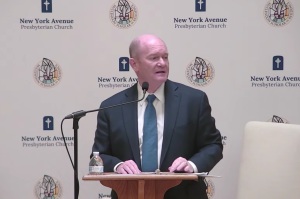Virgin Mary Statues' 'Fashion' Displayed in Museum
Did the Virgin Mary look couture while raising Christ?
The French edition of The Associated Press reports that that's the question asked by "Fashion Icon," a new art exhibit on display at France's Lyon Fabric Museum. Running until March, it collects clothing from the 12th to 19th centuries used to adorn statues of Mary and her holy son.
"Clothes were cut for all kinds of statues – from great icons in sanctuaries and the mannequins used in religious processions, down to the tiny statues of Mary worshiped in convents and household chapels," said Maximilien Durand, the show's curator and director of the Lyon Fabric Museum. "They were dressed like real women, like fashion icons, with real hair, wigs, even make-up."
Durand said the decorating began among Catholics seven centuries ago as a way of showering Mary with affection. By the time of the Reformation, the trend had come under fire for insinuating indecency and the Papacy was forced to review the practice. Ruling in 1530 that divine dress-up was fair game with modest attire, Catholics continued the practice until modern times when it fell out of favor again in the 19th century.
"The clothes people gave were always special, either precious or because they symbolized a key moment in their lives," Durand said. "Women would often donate their wedding dresses for the statues, symbolically as a way of holding onto their virginity. When you clothe a statue, you give it a powerful presence – and since the fabrics used were extremely precious, you also introduce a distance."
The Lyon Fabric Museum's exhibit features many examples of clothing used in French religious ritual. Some of the samples come from the days of Queen Marie-Antoinette, while others came from the famous Daurade basilica the city of Toulouse. Rounding out the collection are dresses designed two years ago by a team of eight designers, chief among them Jean-Charles de Castelbacjac and Franck Sorbier.
Though most of the samples come from the 18th century, Durand said almost all of them symbolize the qualities that make Mary a religious figure still adored today. The clothing's color, for example, changes depending on what Catholic liturgy the statues were dressed for. White was used for feasts, black for mourning, red for remembering martyrs, green for normal displays and purple during Lent.
Flowers, meanwhile, also held significance. Durand said that violets represented Mary’s modesty, lilies her purity and roses her charity.
Seth Whalen, a former model in New York City who now owns PTL Staffing & Events, said that fashion design offered an unusual avenue for spreading the Gospel. During his modeling years, he said he often had the opportunity to talk about God's salvation during his work.
"It's a unique form of ministry mixing fashion and God," Whalen said. "Christianity establishes your identity and the freedom we're given in life. It's crucial to every single human being. It gives you a deep sense of affirmation, acceptance and love that everyone strives for."
Durand, for his part, said that at times critics worried the elaborate clothing detracted from the divine. Citing the Toulouse statue burned in 1789 during the French Revolution, he said the Church cautioned against giving the clothing too much reverence before it was recreated.
"What had come to be considered sacred was the dress," Durand said. "The statue had become secondary."



























